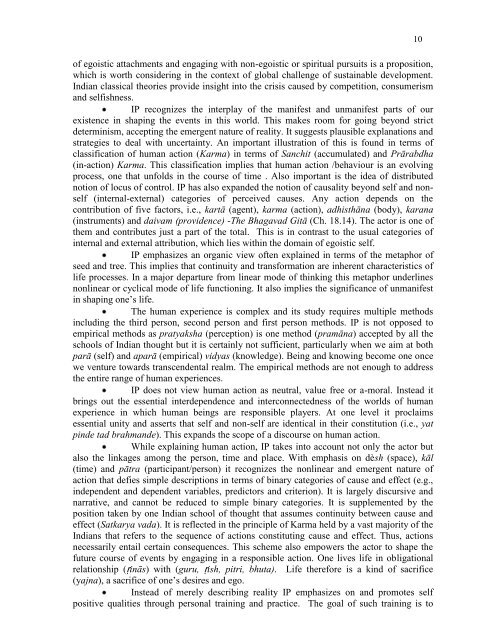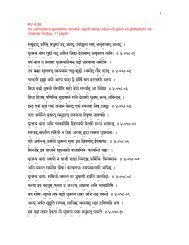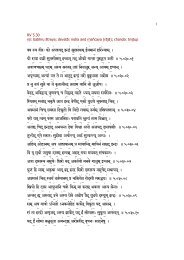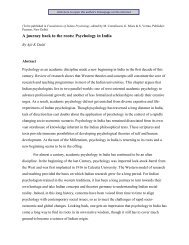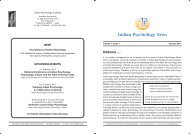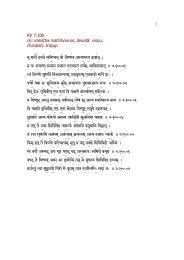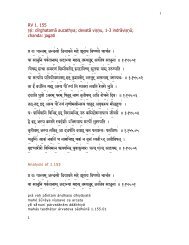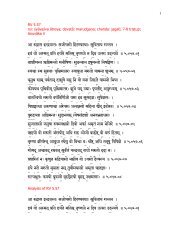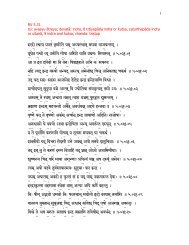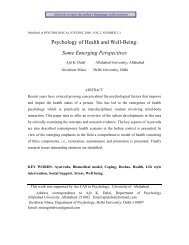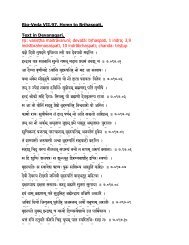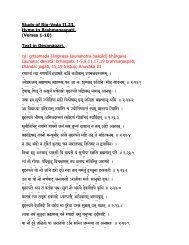core and Context -Fi.. - Indian Psychology Institute
core and Context -Fi.. - Indian Psychology Institute
core and Context -Fi.. - Indian Psychology Institute
You also want an ePaper? Increase the reach of your titles
YUMPU automatically turns print PDFs into web optimized ePapers that Google loves.
of egoistic attachments <strong>and</strong> engaging with non-egoistic or spiritual pursuits is a proposition,<br />
which is worth considering in the context of global challenge of sustainable development.<br />
<strong>Indian</strong> classical theories provide insight into the crisis caused by competition, consumerism<br />
<strong>and</strong> selfishness.<br />
IP recognizes the interplay of the manifest <strong>and</strong> unmanifest parts of our<br />
existence in shaping the events in this world. This makes room for going beyond strict<br />
determinism, accepting the emergent nature of reality. It suggests plausible explanations <strong>and</strong><br />
strategies to deal with uncertainty. An important illustration of this is found in terms of<br />
classification of human action (Karma) in terms of Sanchit (accumulated) <strong>and</strong> Prārabdha<br />
(in-action) Karma. This classification implies that human action /behaviour is an evolving<br />
process, one that unfolds in the course of time . Also important is the idea of distributed<br />
notion of locus of control. IP has also exp<strong>and</strong>ed the notion of causality beyond self <strong>and</strong> nonself<br />
(internal-external) categories of perceived causes. Any action depends on the<br />
contribution of five factors, i.e., kartā (agent), karma (action), adhisthāna (body), karana<br />
(instruments) <strong>and</strong> daivam (providence) -The Bhagavad Gitā (Ch. 18.14). The actor is one of<br />
them <strong>and</strong> contributes just a part of the total. This is in contrast to the usual categories of<br />
internal <strong>and</strong> external attribution, which lies within the domain of egoistic self.<br />
IP emphasizes an organic view often explained in terms of the metaphor of<br />
seed <strong>and</strong> tree. This implies that continuity <strong>and</strong> transformation are inherent characteristics of<br />
life processes. In a major departure from linear mode of thinking this metaphor underlines<br />
nonlinear or cyclical mode of life functioning. It also implies the significance of unmanifest<br />
in shaping one‟s life.<br />
The human experience is complex <strong>and</strong> its study requires multiple methods<br />
including the third person, second person <strong>and</strong> first person methods. IP is not opposed to<br />
empirical methods as pratyaksha (perception) is one method (pramāna) accepted by all the<br />
schools of <strong>Indian</strong> thought but it is certainly not sufficient, particularly when we aim at both<br />
parā (self) <strong>and</strong> aparā (empirical) vidyas (knowledge). Being <strong>and</strong> knowing become one once<br />
we venture towards transcendental realm. The empirical methods are not enough to address<br />
the entire range of human experiences.<br />
IP does not view human action as neutral, value free or a-moral. Instead it<br />
brings out the essential interdependence <strong>and</strong> interconnectedness of the worlds of human<br />
experience in which human beings are responsible players. At one level it proclaims<br />
essential unity <strong>and</strong> asserts that self <strong>and</strong> non-self are identical in their constitution (i.e., yat<br />
pinde tad brahm<strong>and</strong>e). This exp<strong>and</strong>s the scope of a discourse on human action.<br />
While explaining human action, IP takes into account not only the actor but<br />
also the linkages among the person, time <strong>and</strong> place. With emphasis on dèsh (space), kāl<br />
(time) <strong>and</strong> pātra (participant/person) it recognizes the nonlinear <strong>and</strong> emergent nature of<br />
action that defies simple descriptions in terms of binary categories of cause <strong>and</strong> effect (e.g.,<br />
independent <strong>and</strong> dependent variables, predictors <strong>and</strong> criterion). It is largely discursive <strong>and</strong><br />
narrative, <strong>and</strong> cannot be reduced to simple binary categories. It is supplemented by the<br />
position taken by one <strong>Indian</strong> school of thought that assumes continuity between cause <strong>and</strong><br />
effect (Satkarya vada). It is reflected in the principle of Karma held by a vast majority of the<br />
<strong>Indian</strong>s that refers to the sequence of actions constituting cause <strong>and</strong> effect. Thus, actions<br />
necessarily entail certain consequences. This scheme also empowers the actor to shape the<br />
future course of events by engaging in a responsible action. One lives life in obligational<br />
relationship (ṛinās) with (guru, ṛish, pitri, bhuta). Life therefore is a kind of sacrifice<br />
(yajna), a sacrifice of one‟s desires <strong>and</strong> ego.<br />
Instead of merely describing reality IP emphasizes on <strong>and</strong> promotes self<br />
positive qualities through personal training <strong>and</strong> practice. The goal of such training is to<br />
10


